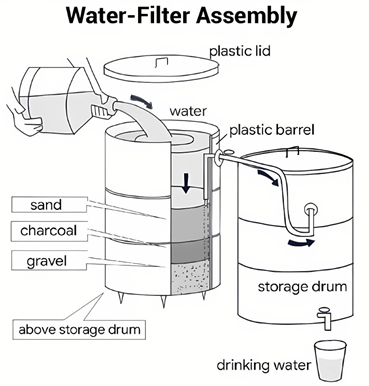5+ The diagram below shows a simple system that turns dirty water into clean water
The diagram below shows a simple system that turns dirty water into clean water. Summarise the information by selecting and reporting the main features, and make comparisons where relevant. Write at least 150 words hay nhất giúp bạn có thêm tài liệu tham khảo để viết bài luận bằng Tiếng Anh hay hơn.
- The diagram below shows a simple system that turns dirty water into clean water (mẫu 1)
- The diagram below shows a simple system that turns dirty water into clean water (mẫu 2)
- The diagram below shows a simple system that turns dirty water into clean water (mẫu 3)
- The diagram below shows a simple system that turns dirty water into clean water (mẫu 4)
- The diagram below shows a simple system that turns dirty water into clean water (mẫu 5)
- The diagram below shows a simple system that turns dirty water into clean water (mẫu 6)
- The diagram below shows a simple system that turns dirty water into clean water (mẫu 7)
- The diagram below shows a simple system that turns dirty water into clean water (mẫu 8)
5+ The diagram below shows a simple system that turns dirty water into clean water
Đề bài: The diagram below shows a simple system that turns dirty water into clean water. Summarise the information by selecting and reporting the main features, and make comparisons where relevant. Write at least 150 words
The diagram below shows a simple system that turns dirty water into clean water - mẫu 1
The given diagram illustrates how to produce drinking water by using a simple water-filter assembly device. Overall, the system consists of two storage drums arranged to filter and then store the water. There are four main stages in the process, starting with pouring in unclean water, followed by filtering and storage, and culminating with opening of the tap for clean water.
In the first two stages, after the lid has been removed, unpurified water is poured into an initial, elevated plastic drum. The water then penetrates downwards through three filtering layers. Initially, the water undergoes a sand filtration process to eliminate impurities, subsequent to a further filtration step involving a layer of charcoal, and purification through the utilization of gravel. A pipe system with one end at the bottom of this drum then leads the purified water down to the less elevated storage drum.
In the final stages, the filtered water is stored in the lower drum with a closed lid. A tap near the bottom of this drum allows users to utilize the cleaned drinking water.
The diagram below shows a simple system that turns dirty water into clean water - mẫu 2
The diagram illustrates a simple method of purifying dirty water in order to make it suitable for consumption.
Overall, the system demonstrates how easily accessible natural materials and basic equipment can be used to produce drinkable water in just a few simple steps.
Overall, the system showcases how readily available natural materials and basic equipment can be utilized to produce drinkable water in just a few straightforward steps.
Firstly, a storage drum and a plastic barrel are positioned adjacent to each other, with the top of the latter higher than the former. These two components are connected by a pipe running from the bottom of the barrel into the side of the drum. Subsequently, a filter is constructed within the barrel by adding layers of sand, charcoal, and gravel. Lastly, a tap is installed at the bottom of the drum, and another one is placed at the top of the pipe.
The process commences by lifting the plastic lid of the barrel and pouring impure water into it. The water then passes through the filter and travels up the pipe into the drum, where it is stored. When the tap in the drum is opened, potable water is released for use.
The diagram below shows a simple system that turns dirty water into clean water - mẫu 3
The provided diagrams illustrate a simple water filtration system designed to purify water.
Overall, the water filter assembly employs a two-tank setup - one for filtration and one for storage - utilizing natural materials in a layered approach to remove impurities.
When it comes to the design, the plastic barrel, capped with a plastic lid to ensure the water remains uncontaminated during the process, is segmented internally into three sections with layers of sand, charcoal, and gravel. Below the filtration barrel is the storage tank, or drum, which functions as a reservoir for the filtered water. This drum is strategically positioned to collect water exiting the filtration tank and is fitted with a tap at its base.
The purification process begins with the pouring of dirty water into the filtration barrel, where it first encounters the sand layer. The water then descends to the charcoal layer, which is instrumental in removing dissolved impurities, due to its adsorption capabilities. The final layer of gravel not only filters out any remaining larger particles but also regulates the flow of water into the storage drum. The filtered water travels from the barrel to the drum through a connecting pipe. Once in the storage drum, the water is ready for consumption and can be dispensed through the tap.
The diagram below shows a simple system that turns dirty water into clean water - mẫu 4
The diagram illustrates the construction and function of a basic water filtration system, designed to produce clean drinking water.
It is evident that the process involves five main steps, commencing with the intake of impure water and concluding with the availability of portable water from the tap.
The setup comprises two distinct tanks interlinked by a connecting tube. The upper section of the initial tank is shielded by a thin circular cover, while its lower portion is packed with three layers of materials, namely sand, charcoal, and gravel. The second tank functions as a reservoir for filtered water and is equipped with an integrated tap.
To initiate the process, untreated water is introduced into the first tank. Subsequently, the water flows sequentially through the layers of sand, charcoal, and gravel. Within each layer, impurities from the raw water are captured, facilitating the purification process. The clarified water is then directed to the second tank for storage through a conduit. At this stage, the water is ready for use and can be accessed via the tap.
The diagram below shows a simple system that turns dirty water into clean water - mẫu 5
The provided diagram demonstrates the construction of a simple water filter as well as its function to produce potable water. It is noticeable that water is treated through 5 main steps, starting with impure water and finishing with drinkable water from the tap.
The system consists of 2 separate tanks connected with each other through a tube. The top of the first tank is covered by a thin round lid and its bottom half is filled with 3 layers of substances, namely, sand, charcoal, and gravel. The second tank serves as a storage container of filtered water with a built-in tap.
At the beginning of the process, raw water is poured into the first tank. After that, the water goes down through the sand layer, charcoal layer, and gravel layer in chronological order. The waste from impure water is trapped within the given layers, enabling the process of removing impurities from water. Subsequently, filtered water is transferred to the second tank for storing purpose through a conduit. At this stage, water is ready for use and can be dispensed by using the tap.
The diagram below shows a simple system that turns dirty water into clean water - mẫu 6
The picture illustrates the system used to transform unpurified water into drinkable water. Overall, the process involves two main stages, which are filtering unclean water through various materials in a plastic barrel and storing purified water in a storage drum.
The water-filter process begins when water is poured into a plastic barrel placed above a storage drum and then covered by a plastic lid. After that, the water is purified by going through three different layers of materials: sand, charcoal and gravel, in that order. While the amount of sand and gravel is rather similar, that of charcoal is half as much.
In the second stage, the purified water is transmitted to the storage drum by a pipe which leads from the bottom of the plastic barrel to the upper part of the storage drum. Throughout this stage, the storage drum remains closed with a plastic lid. Finally, the clean water is taken via a faucet located near the bottom of the storage drum for drinking purposes.
The diagram below shows a simple system that turns dirty water into clean water - mẫu 7
The provided diagram illustrates the straightforward process by which water is filtered. Overall, the process employs uncomplicated equipment and relies on the natural properties of different materials to remove impurities from water.
Regarding the equipment and ingredients, the key components necessary for this method are a sizable container and three essential ingredients namely sand, charcoal, and gravel. These elements are arranged in layers, designed to progressively remove contaminants. Specifically, the bottom layer is gravel, on top of which is a layer of clean sand and then another layer of crushed charcoal.
The process begins when untreated water is poured into the container and undergoes a filtering phase. During this stage, water passes through the layers, with larger debris being trapped in the gravel, followed by smaller particles being trapped in the sand, and some contaminants being absorbed by the charcoal.
After successfully passing through all three layers, the water emerges filtered and purified, now ready for drinking. Subsequently, a pipe is affixed to the container so as to transfer the filtered water into a separate storage tank, where it remains available for utilization whenever required.
The diagram below shows a simple system that turns dirty water into clean water - mẫu 8
The diagram below illustrates how a simple water filter is constructed and how it functions to produce clean drinking water. Write a report for a university lecturer describing the diagram below.
A glance at the diagram depicts some striking information about the process in which impure/ polluted/ contaminated/ dirty water is filtered/ purified/ treated.
It is evident from the information supplied that there are several main steps involved in the process. It starts with (N + Vpii) dirty water collected and ends with drinking water produced.
Looking at the components of the system in more detail, people prepare a plastic barrel and a storage drum which are positioned next to each other with the former placed higher than the latter. The barrel is covered with a plastic lid. Moreover, people put 3 layers including sand, charcoal and gravel into the bottom of the barrel. There is a small tube/ pipe which runs from the bottom of the barrel to the side of the drum. On the lower part of the side of the drum, people install a tap.
Regarding the process of filtering water, at the beginning, dirty water is poured into the barrel. Then, it runs through the filtering layers which help keep substances. After that the clean water is sent to the drum via the tube. When people open the tap, the clean water flows out, ready for consumption/ use.
Xem thêm các bài luận Tiếng Anh hay khác:
Đã có app VietJack trên điện thoại, giải bài tập SGK, SBT Soạn văn, Văn mẫu, Thi online, Bài giảng....miễn phí. Tải ngay ứng dụng trên Android và iOS.
Theo dõi chúng tôi miễn phí trên mạng xã hội facebook và youtube:Nếu thấy hay, hãy động viên và chia sẻ nhé! Các bình luận không phù hợp với nội quy bình luận trang web sẽ bị cấm bình luận vĩnh viễn.
- Đề thi lớp 1 (các môn học)
- Đề thi lớp 2 (các môn học)
- Đề thi lớp 3 (các môn học)
- Đề thi lớp 4 (các môn học)
- Đề thi lớp 5 (các môn học)
- Đề thi lớp 6 (các môn học)
- Đề thi lớp 7 (các môn học)
- Đề thi lớp 8 (các môn học)
- Đề thi lớp 9 (các môn học)
- Đề thi lớp 10 (các môn học)
- Đề thi lớp 11 (các môn học)
- Đề thi lớp 12 (các môn học)
- Giáo án lớp 1 (các môn học)
- Giáo án lớp 2 (các môn học)
- Giáo án lớp 3 (các môn học)
- Giáo án lớp 4 (các môn học)
- Giáo án lớp 5 (các môn học)
- Giáo án lớp 6 (các môn học)
- Giáo án lớp 7 (các môn học)
- Giáo án lớp 8 (các môn học)
- Giáo án lớp 9 (các môn học)
- Giáo án lớp 10 (các môn học)
- Giáo án lớp 11 (các môn học)
- Giáo án lớp 12 (các môn học)






 Giải bài tập SGK & SBT
Giải bài tập SGK & SBT
 Tài liệu giáo viên
Tài liệu giáo viên
 Sách
Sách
 Khóa học
Khóa học
 Thi online
Thi online
 Hỏi đáp
Hỏi đáp

